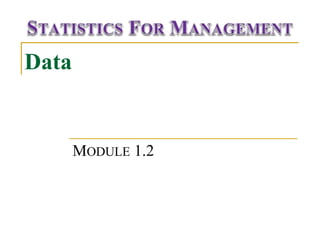
What is Data? in Statistics
- 2. TOPICS TO BE COVERED Students Survey What is Data? Types of Data
- 4. Sample Student Survey Form Name of the Student:______________________________ 1. What is your age?______________________ (in years) 2. Specify your Gender. Male Female 3. Which city you prefer in MP. Indore Bhopal Gwalior 4. How many chocolates you eat in a day.______________(Units) 5. Rate Chennai “BOL BACHAAN” Express Movie: Haven’t Seen 1 Star 2 Stars 3 Stars 4 Stars 5 Stars 6. How many movies you watch in a month.______________(Units)
- 5. WHAT YOU ARE SUPPOSE TO DO?Ch?oo?se one question and summarize the results. Analyze the difference between the questions and response.
- 7. DATA Data are the observed values of a variables. Variables are any characteristics of our objects or observation. An object can be: People Laptops Mobiles Class Room
- 8. DATA For example, Students in this class are Objects Their characteristics can be age, gender, height etc These are the variables, because this would vary from person to person. And if we put this data into a table or a spreadsheet, then
- 10. DATA The data can be obtained by: Measuring (height or weight) Counting Asking (marital status or graduation) Observing (gender or skin color) Computing (BMI)
- 11. Types of Data
- 12. TYPES OF DATA The type of data determines which: Summary Statistics Graphs Analysis Are possible and sensible to be applied on the object?
- 13. TYPES OF DATA CATEGORICAL DATA This kind of data deals with the QUALITATIVE options of the objects. For example, gender, marital status. Usually questions about categorical data are answered with words.
- 14. MALE-FEMALE V/S CHENNAI EXYPou say that both these data are qualitative or categorical. Then is there any difference between the two. Gender Objective Kind Its not ranking, its just word or labels with no rank or order. There is no such logic put in. Movie Rating Subjective Kind Ranking is carried out, from lowest to highest in a order. Logic of rating may differ from person to person.
- 15. CATEGORICAL DATA As there can be different kind of qualitative data, thus we need a different kind of scale to measure them.
- 16. TYPES OF DATA CATEGORICAL DATA NOMINAL LEVEL It is the most basic level of measurement of the variable. These are descriptions or labels with no sense of sequence.
- 17. NOMINAL LEVEL GENDERS PREFERED CITY IN MP COLORS These are descriptions or labels. With no sense of sequence or order. These can stored as word or text or can be given a numerical code. •MALE •Indore •FEMALE •Bhopal •Gwalior •RED •BLUE •YELLOW •WHITE 1. MALE 1. Indore 2. FEMALE 2. Bhopal 3. Gwalior 1. RED 2. BLUE 3. YELLOW 4. WHITE To summarize a nominal data we use frequency or percentage. We cannot calculate mean or average value of nominal data.
- 18. TYPES OF DATA CATEGORICAL DATA NOMINAL LEVEL ORDINAL LEVEL
- 19. ORDINAL LEVEL •Ecstasy •Delight •Satisfied •Not Satisfied •1st Rank •2nd Rank •Rank •1st Rank (98.3%) •2nd Rank (97.2%) •3rd Rank (92.3%) SATISFACTION RANK They have meaningful order. But the intervals between the values in this scale may not be equal. Like nominal data, ordinal data can be given as frequencies or percentages.
- 20. TYPES OF DATA NUMERICAL DATA CATEGORICAL DATA NOMINAL LEVEL ORDINAL LEVEL This kind of data deals with the QUANTITATIVE options of the objects. This includes things, which can be measured rather which can be classified or ordered.
- 21. AGE V/S CHOCOLATE COYoNuS saUyM thPatT bIoOthN these data are quantitative or numeric. Then is there any difference between these two. Age Measurement or Calculation is done Its kind of a continuous data, and the accuracy of exact age may typically depend on the units used. It can be in fractions. Chocolates Counting Its kind of fixed numbers. It will generally be in a whole number.
- 22. TYPES OF DATA NUMERICAL DATA CATEGORICAL DATA NOMINAL LEVEL ORDINAL LEVEL DISCRETE DATA
- 23. DISCRETE DATA Number of questions in a paper Number of students in the class These are quantitative data with whole numbers. A type of data is discrete if there are only a finite number of values possible. Discrete data usually occurs in a case where there are only a certain number of values, or when we are counting something.
- 24. TYPES OF DATA NUMERICAL DATA CATEGORICAL DATA NOMINAL LEVEL ORDINAL LEVEL DISCRETE DATA CONTINUOUS DATA
- 25. CONTINUOUS DATA Weight Height These are quantitative data with fractional numbers. Continuous data makes up the rest of numerical data. This is a type of data that is usually associated with some sort of physical measurement. Continuous data usually occurs in a case where we are measuring or calculating something. One general way to tell if data is continuous is to ask yourself if it is possible for the data to take on values that are fractions or decimals. If your answer is yes, this is usually continuous data.
- 27. TYPES OF DATA NUMERICAL DATA CATEGORICAL DATA NOMINAL LEVEL ORDINAL LEVEL DISCRETE DATA CONTINUOUS DATA
